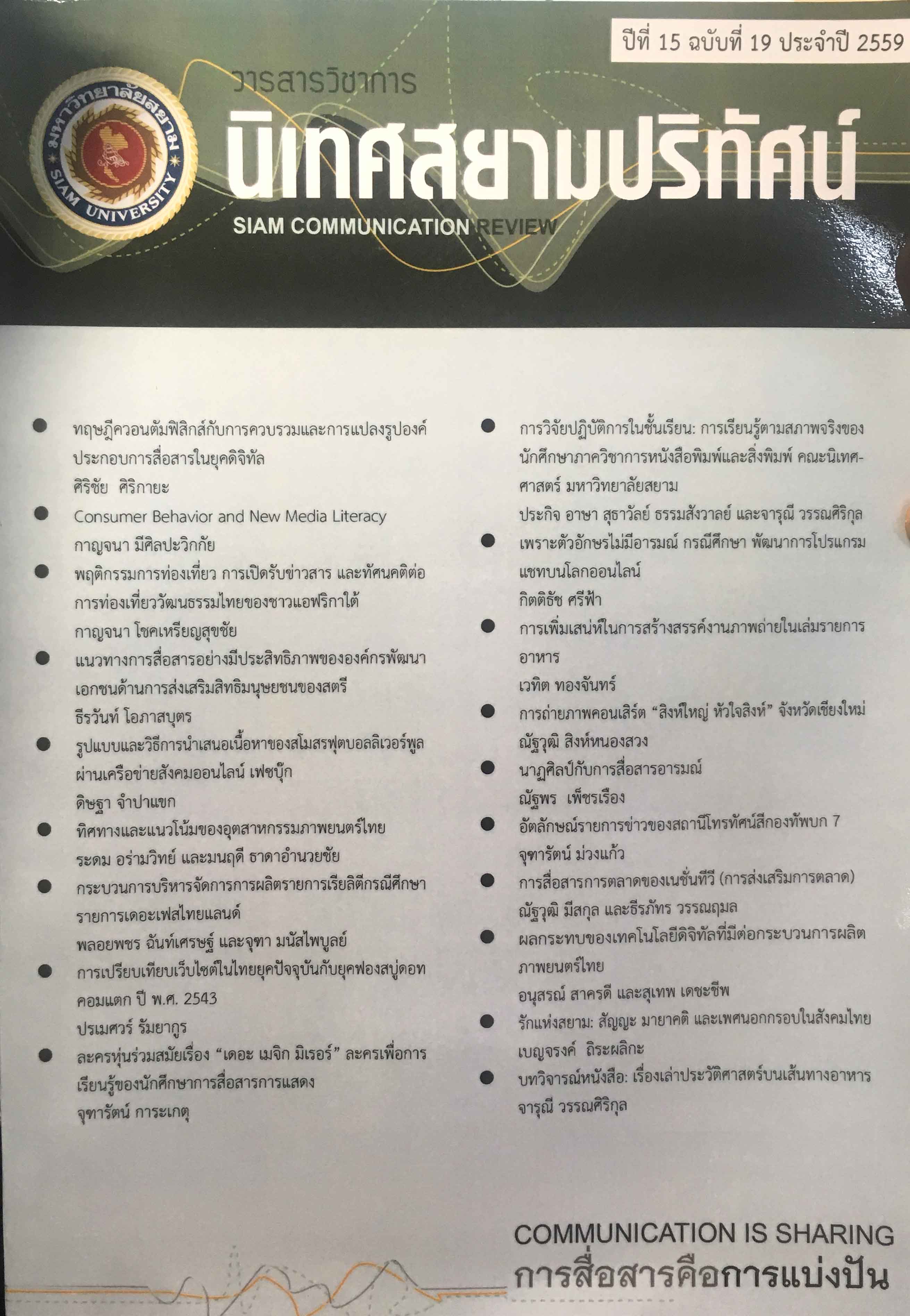The Travel Behavior, the Media and Information Exposure and the Attitude on Thai Cultural Universals of South African People
Main Article Content
Abstract
The purposes of this research article are: to study the travel behavior, the media and information exposure and the attitude on Thai cultural universals of 464 South African people. The questionnaire has a confidence level of 0.97 and survey in two different ways by a group of people and through the Internet in South Africa. The study found that most South African people had frequency travel in and out of country uncertainty and occasionally. They preferred traveling with friends, visiting technology or entertainment places, searching travel information and known tourist destinations in Thailand via internet. The South Africans had known Thai bodily adornment, Thai Cooking and Thai Education. If they had a chance to visit Thailand, they would like to participate in carving stones to make body decorations, and to enhance the richness and for luck. The result had shown that the perception on Thai cultural universal was associated with media exposure in the overall level of statistical significance. 05 (r =.137). It could be said that perception of South African people on Thai cultural universals depend on media exposure of Thai tourism. The result had showed that Thai cultural universal perception was associated with the demand of activities of the South African in different significance level. 05. In other words, participation in activities related to Thai cultural universals based on the known of Thai Cultural Universals in any aspects.
Article Details
References
กรมการท่องเที่ยว กระทรวงการท่องเที่ยวและกีฬา. (2556). ข้อมูลสถิติการเข้าเมืองของนักท่องเที่ยว. สืบค้นจาก www.tourism.go.th
กาญจนา โชคเหรียญสุขชัย. (2557). พฤติกรรมการเปิดรับสื่อ การค้นหาข่าวสาร และการรับรู้วัฒนธรรมไทยสากลเพื่อการสื่อสารท่องเที่ยวสำหรับประชาชนในกลุ่มประเทศอินโดจีน (รายงานผลการวิจัย). มหาวิทยาลัยหอการค้าไทย, กรุงเทพฯ.
เกียรติสุดา ศรีสุข. (2552). ระเบียบวิธีวิจัย. เชียงใหม่: โรงพิมพ์ครองช่าง.ข่าวเศรษฐกิจ. (2553, 28 มิถุนายน). แนวหน้า, น. 9.
จรัสศรี ปักกัดตัง. (2542). ศึกษาความแตกต่างและความสัมพันธ์ระหว่างลักษณะทางประชากร การเปิดรับข่าวสาร การรับรู้ และทัศนคติของผู้ใช้อินเทอร์เน็ตที่มีต่อการประชาสัมพันธ์ผ่านสื่ออินเทอร์เน็ตของหน่วยงานภาครัฐ (วิทยานิพนธ์ปริญญามหาบัณฑิต ไม่ได้ตีพิมพ์). จุฬาลงกรณ์มหาวิทยาลัย, กรุงเทพฯ.
พรทิพย์ ศิริชูทรัพย์. (2542). การเปิดรับข่าวสาร ความรู้ ทัศนคติ และการมีส่วนร่วมต่อปัญหาสังคมของกลุ่มผู้ใช้สื่ออินเทอร์เน็ต บนเว็บไซต์ขององค์กรพัฒนาเอกชน (วิทยานิพนธ์ปริญญามหาบัณฑิต ไม่ได้ตีพิมพ์). จุฬาลงกรณ์มหาวิทยาลัย, กรุงเทพฯ.
พัชนี เชยจรรยา และคณะ. (2541). แนวคิดหลักนิเทศศาสตร์. กรุงเทพฯ: จุฬาลงกรณ์มหาวิทยาลัย.
วิลาวัณย์ เรืองปฏิกรณ์. (2546). ความสัมพันธ์ระหว่างพฤติกรรมการเปิดรับสื่อเพื่อการสื่อสารการตลาดกับความรู้ ทัศนคติ และพฤติกรรมการท่องเที่ยวไทยในโครงการไทยเที่ยวไทย (วิทยานิพนธ์ปริญญามหาบัณฑิตไม่ได้ตีพิมพ์). มหาวิทยาลัยธรรมศาสตร์, กรุงเทพฯ.
ภาษาอังกฤษ
Bennett, M. M., & Chi-Wen Kevin. (2005). The Impact of the Internet on Travel Agencies in Taiwan. Tourism & Hospitality Research, 6(1), 8-23.
Bower, J.A., & Saadat, M.A. (1998). Consumer Preference for Retail Fat Spreads: an Olive Oil Based Product Compared with Market Dominant Brands. Food Quality Preference, 9(1), 367-376.
Cohen, J., & Weimann, G. (2000). Cultivation Revisited: Some Genres Have Some Effects on Some Viewers. Communication Reports, 13(2), 99–114.doi:10.1080/08934210009367728
Garrett, R. K. (2009a). Echo Chambers Online? Politically Motivated Selective Exposure among Internet News Users. Journal of Computer-Mediated Communication, 14(1), 265–285.
George, P. M. (1945). The Common Denominator of Culture. In Ralph Linton (Ed.), the
Science of Man in the World Crisis (pp. 123-142). NY: Columbia University Press.
Hwang, Y. (2010). Selective Exposure and Selective Perception of Anti-Tobacco Campaign Messages: The Impacts of Campaign Exposure on Selective Perception. Health Communication, 25(2), 182-190.
Jong, W. J, Hyung, S. L & Jae Hee Park. (2009). Roles of Media Exposure and Interpersonal Experiences on Country Brand: The Mediated Risk Perception Model. Journal of Promotion Management, 15(1-2), 321-339.
Knobloch-Westerwick, S., & Meng, J. (2009). Looking the Other Way Selective Exposure to Attitude-Consistent and Counter-attitudinal Political Information. Communication Research, 36(3), 426-448.
Knobloch-Westerwick, S. (2012). Selective Exposure and Reinforcement of Attitudes and Partisanship before a Presidential Election. Journal of Communication, 62(4), 628-642.
Kobayashi, T., & Ikeda, K. (2009). Selective Exposure in Political Web Browsing: Empirical Verification of ‘Cyber-balkanization’ in Japan and the USA. Information. Communication & Society, 12(6), 929-953. doi:10.1080/13691180802158490
Melican, D. B., & Dixon, T. L. (2008). Credibility, Selective Exposure and Racial Prejudice. Communication Research, 35(2), 151-168.
Ramona, G., Gheorghe, P. & Roxana, N. (2008). Comparing the Effectiveness of the Website with Traditional Media in Tourism Industry Marketing. Retrieved from steconomi ceuoradea.ro
Rasty, F., Chou, C., & Feiz, D. (2013). The Impact of Internet Travel Advertising Design, Tourists’ Attitude and Internet Travel Advertising Effect on Tourists’ Purchase In tention: The Moderating Role of Involvement. Journal of Travel & Tourism Market ing, 30(5), 482-496.
Rosenberg, M. J., & Hovland, C. I. (1960). Cognitive, Affective and Behavioral Components of Attitudes, In C.I. Hovland and M.J. Rosenberg (Eds.), Attitude Organization and Change: An Analysis of Consistency among Attitude Components (pp. 1-14.). New Haven, CT: Yale University Press.
Schramm, W. (1973). How Communication Work’s. In D. C. Mortensen (Ed.). Basic Reading in Communication Theory (pp. 28-36). NY: Harper and Row Publishers.
Shepard J. M. (2010). Sociology: Cengage Advantage books (10th ed.). CA: Wadsworth Cengage Learning Belmont.


